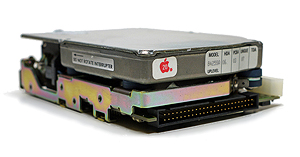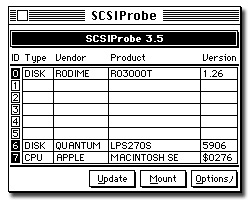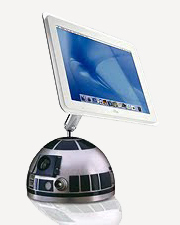Formatting Old Mac SCSI Drives
Anyone who’s been using Macs since the days when SCSI was the primary expansion bus knows that this technology was not something often described as plug-and-play. SCSI did work, but not without challenges. I was reminded of some of these working on a file transfer job this weekend.
 A client sent me a working Macintosh Classic II running System 7.0.1, with several old projects on the internal hard drive. They wanted to get this data transferred and converted to something modern. Since it was bootable and had an external SCSI port, I decided to hookup an external drive to copy the data rather than open the case and pull out the boot disk, or wait for things to sputter along using LocalTalk.
A client sent me a working Macintosh Classic II running System 7.0.1, with several old projects on the internal hard drive. They wanted to get this data transferred and converted to something modern. Since it was bootable and had an external SCSI port, I decided to hookup an external drive to copy the data rather than open the case and pull out the boot disk, or wait for things to sputter along using LocalTalk.
I pulled an 80MB drive from my stack of spares, hooked it up to a SCSI sled (a coverless external case), and connected this to my PowerBook Wallstreet to format the disk. 68k Macs require disks to be formatted in the Mac OS Standard (HFS) filesystem, not the newer Mac OS Extended (HFS+) flavor. The Wallstreet runs Mac OS 9.2.2, and the included disk utility is called Drive Setup. I mounted the old (noisy) transfer drive, selected Mac OS Standard format, and quickly partitioned the disk.
I then spent the next two hours trying to get this hard drive mounted by the Classic. And reminded myself why I like FireWire drives so much better.
SCSI chains require each device on the bus to have a different ID number, and both ends of the chain need to be terminated. On older Macs the internal hard drive was set to SCSI ID 0 and terminated at the motherboard; the system itself used SCSI ID 7. Any external devices need to use ID 1-6, with a terminator. I configured my drive as ID 2, added a passive external terminator, and booted up the Mac.
A loud whining sound immediately started emanating from the machine. If I moved the external SCSI cable even slightly the whine changed pitch. Hmmm, that sounded like a motherboard component about to fail. The Mac booted but the drive didn’t appear on the desktop, so I used a floppy disk to load the SCSIProbe control panel and scanned the bus. No external disk found. But the whine continued.
 I shut down and swapped the SCSI cable out for another. After a few minutes the whine went away. Such are the risks of old hardware. Still no go on mounting the external drive though, and now SCSIProbe was complaining about a lack of termination on the bus.
I shut down and swapped the SCSI cable out for another. After a few minutes the whine went away. Such are the risks of old hardware. Still no go on mounting the external drive though, and now SCSIProbe was complaining about a lack of termination on the bus.
These classic Macs with their slow SCSI speeds didn’t typically require active termination, but it was the next thing to try. Dug one out of a drawer, and bingo that solved problem number two.
The drive still didn’t mount on the desktop, but SCSIProbe did now see it on the bus – progress. I clicked the Mount button and got an error message that drives larger than 4GB are not supported on 68k Macs. 4GB? This drive is only 80MB. What gives?
I grabbed another 160MB drive from my shelf, connected this to the Classic, and it mounted fine – yay! But this one contained some data I needed to backup first, so I again powered down, hooked the drive up to my Wallstreet, and copied what I needed. When finished I reformatted the disk for good measure, again using Mac OS Standard.
Back on the Classic, I got the same error: can’t read drives larger than 4GB. Huh? It just read that drive. All I did was connect it to the Wallstreet, copy, and… reformat.
Using the Drive Setup utility included with Mac OS 9.2.2.
Another distant memory surfaced: back in the System 7 days (and earlier), Apple used a different utility for formatting disks called Apple HD SC Setup. The name goes back to the very first Mac external hard drive, and the interface is minimal at best, but version 7.3.5 still ran under OS 9. It was worth a try. Launch, click Initialize, wait 15 minutes, and presto: one freshly formatted prehistoric Mac OS hard drive.
I held my breath booting up the Classic again. It chimed, smiled its happy Mac face at me, then quickly and transparently mounted the external drive on the desktop. Finally! Two hours after I started the process – LocalTalk would probably have been done in half the time. But as they say, it was a (Re)Learning Experience.
SCSI Voodoo. Yep. And you thought USB is a headache…


Thanks for sharing your experience. Very useful information.
great job adam..
great site.. great effort.. a++